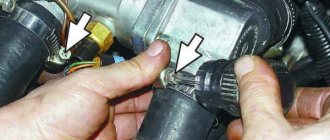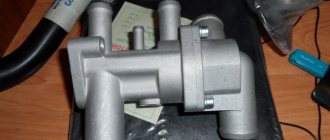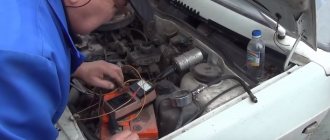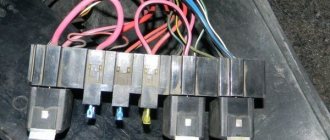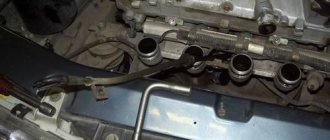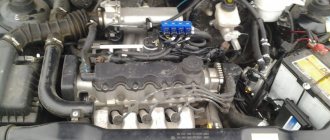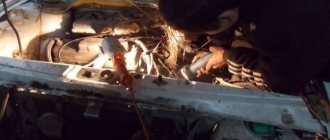Common Causes
As you know, the VAZ 2110 is equipped with two types of engines - with 8 and 16 valves. There are several main, most common reasons that cause this overheating of power units.
Let's look at each of the reasons and ways to resolve these problems separately.
Tens engine
Low coolant level
Coolant plays a huge role in the operation of the cooling system. A special substance, namely antifreeze or antifreeze, is poured into the expansion tank.
Related material:
In a normal situation, the level of the coolant solution should be at the level of, or rather the MAX marks on the tank body. This indicates that the container is approximately 50-60 percent full.
If there is no such mark on the tank, refer to the clamp. The liquid should reach its upper edge.
- If the engine overheats, try simply adding the missing amount of coolant so that it is at the optimal filling level.
- If you have not changed the coolant for a long time, it is better not to add new coolant, but simply replace it completely with new coolant.
- When choosing between antifreeze and antifreeze, most VAZ 2110 owners prefer the first. And mainly due to the financial availability of antifreeze. But in practice, antifreeze is better . One of its most important advantages is that the substance does not freeze in severe frosts. For individual regions of our country, this is a key factor in the choice of coolant.
Thermostat
Another reason for engine overheating is a stuck thermostat valve. If it remains in the closed position and does not open, the coolant will move only along a small circuit. As a result, this will lead to strong heating of the power plant. Overheating itself threatens with very, very serious consequences.
Such a malfunction can manifest itself at the most inopportune moment - on the road. You are unlikely to be able to carry out high-quality repairs on the side of the road. But you can try one method - knock on the thermostat housing. Often this allows you to return the device to its functionality for a while. This way you can get to your own garage or the nearest service station. There the thermostat has already been replaced with a new one. There is no point in repairing it. If he failed once, the situation will certainly repeat itself soon.
Related material:
Thermostat in the engine
temperature sensor
A temperature sensor is necessary in order to respond to changes in engine heating. When a preset point is reached, the sensor is triggered and turns on the cooling fan.
If this device malfunctions, the power unit overheats because the fan does not activate. Consequently, the temperature does not fall below critical levels, but continues to gradually rise.
Related material:
If you encounter such a problem on the road (most often the engine overheats while stuck in traffic jams, since the engine is running but there is no flow of cooling oncoming air), try to get out of the jam as quickly as possible and find a free section of the road.
Accelerate during the free stretch and then begin engine braking. This will lower the temperature and prevent overheating. Under no circumstances should you regularly operate your car this way. But this is a great way to get to a garage or auto repair shop, determine the cause of the sensor failure, and then replace it.
Cooling Fan
The symptoms of fan malfunctions are similar to a non-working temperature sensor. That is, the engine will heat up, the indicator on the dashboard will be in the red zone.
Related material:
Again, while on the road, we recommend using the engine braking method. Next, head to the garage. Let the car cool down. In the meantime, go to the store for a new fan. This device for the VAZ 2110 costs about 600 rubles.
Fan problems
Other reasons
There are other equally popular reasons for engine overheating. Therefore, we invite you to familiarize yourself with all of them in our table.
Cause of overheating
Remedy
Coolant level too low
Add coolant to the required level, following the marks or clamp on the expansion tank
The radiator is clogged or blocked
Flush the radiator. If this does not help, the unit must be replaced
The cooling system pump has failed (the impeller slips on its internal shaft)
It's best to replace the pump
The oil level in the lubrication system is critical
Add oil to the required level. If it is old, change the oil
The ignition timing is incorrectly set
Perform torque adjustment
The thermostat has failed
Replace the device with a similar new one
The cooling fan motor has failed
It can be repaired, but it is better to install a new motor
When faced with such a phenomenon as engine overheating, do not rush to send your VAZ 2110 for repair to a car service center. You can find many causes of overheating with your own hands and deal with them yourself. Service station services are not cheap these days, unfortunately.
Source
Reasons that can cause overheating
- Lack of coolant . The liquid in the engine boils not because there is not enough of it, but here’s why: remember about the outer surface for cooling? If there is a lack of fluid, the contact surface between the fluid and the heated engine is insufficient, and heat transfer to the environment is poor. This is where the overheating comes from. The engine cooling system is not sealed, as many believe, and fluid evaporates during operation - do not forget to check its level regularly. And of course, monitor the condition of the radiator and pipes - leaks are unacceptable. There are cases of internal leakage - as a result of damage to the gasket between the head and the cylinder block. Water will not flow out of the exhaust pipe, but a constant decrease in the fluid level without visible leaks is a reason to be wary and contact a specialist. Water accumulated in the cylinders at the moment of starting the engine can lead to water hammer - this can literally destroy the piston group, and not only that.
- Radiator condition . The gaps between the radiator honeycombs are quite small and can gradually become contaminated by representatives of the insect world. This is not a joke; there was a case when minor contamination of the radiator (coupled with the poor condition of the engine) led to constant overheating of the car. Keep the radiator clean and blow it with compressed air at least occasionally.
- Incorrectly set ignition angle . If the ignition angle is violated, the fuel combustion process is disrupted. As a consequence, an increase in combustion temperature and a decrease in power. The power has dropped, but there is no need. What are we doing? That's right - press the gas pedal harder. It turns out that more fuel is spent on the design operating mode of the engine (at which normal cooling occurs). Hence the overheating. By the way, an ignition problem can arise (spontaneously, and not after your intervention in the finely tuned engine mechanism) if the timing belt or chain is stretched. This is not the only possibility, but it is common - keep in mind.
- Fuel quality . An inappropriate octane number leads to a decrease in power and an increase in the temperature of fuel combustion. There is only one way out - refuel in one place, so the likelihood of getting bad gasoline is lower.
- Deposits on the walls of the engine and radiator . The reason is simple - the use of low-quality coolant, or even water. A little more detail. From a physics point of view, using water is better, since water has better thermal conductivity than alcohol-containing antifreeze. But - there are salts in the water (you can see them on the walls of the kettle) - the same thing happens inside the engine. As a result, water circulation is disrupted, cooling efficiency is reduced and the engine overheats. If you are pouring water into the expansion tank, pour distilled water, it is free of salts. It is best to use special antifreeze. Believe me, it is impossible to completely remove scale from the engine. And one more “beauty of water: if, after water, for example in winter, you fill in antifreeze - be prepared for drips (it can leak anywhere: radiator, pipes) - this is a fact. If you constantly drive “on antifreeze,” nothing will happen, but after water, antifreeze will flow 99%.
- Engine wear . This can include many aspects, but in most cases it is wear of the piston group. During long-term use of the car, the piston rings, which serve to seal the combustion chamber, wear out, which leads to a decrease in compression, impaired fuel combustion, loss of power (remember the formula) and overheating of the car. Somehow it turned out to be too difficult. To put it simply: fuel burns better at a certain pressure that is created in the combustion chamber. Pressure is about 12 atmospheres. If you take a pipe, plug it with potatoes and blow inside, pressure will be created inside, which is called compression. The force with which you blow will represent the force of expansion of the fuel during combustion, which pushes on the piston and causes the crankshaft to rotate. The rings serve to fit the piston more tightly to the cylinder (in our case, potatoes and tube). Now, if you put in a loose piece of potato and blow, the air will pass past the potato piston. This is what happens in the engine when the piston group wears out (ring wear and cylinder wall wear). As a result, part of the expansion energy of the fuel during combustion passes by the piston (between the piston and the cylinder), and compression (optimal pressure in the combustion chamber) decreases, which worsens the quality of combustion. And again - loss of power and overheating. There is only one way out - contact a specialist.
- Radiator fan . In some (older) car models, there was no such reason, since the fan was driven directly from the crankshaft through a belt. Now, the fans are electric and turn on when the temperature sensor is triggered. The sensor may not work, and the fan may not turn on. This is a fairly common reason. You just have to go out and look - the motor connection contacts may be oxidized.
- Air pockets formed when filling liquid. By the way, in this case the temperature sensor may not show an increase in temperature. How to get rid of a traffic jam is the topic of a separate article. I’ll add on my own – when pouring liquid into the cooling system, the car must be horizontal.
- Thermostat . The thermostat divides the cooling system into two circles - small and large. The small one is used to warm up the car (the amount of liquid is reduced, the radiator is turned off), when a certain temperature is reached, the large circle is connected (the radiator is connected). If the thermostat is jammed, then only the small circle is used: the amount of fluid is insufficient, the radiator is turned off - the car is overheating. You can determine this by feeling the lower pipes leading to the radiator: if they are cold and the car is overheated, change the thermostat.
- Water pump . A pump is a pump that forcibly displaces water to improve circulation. By and large, two troubles can happen to the pump: it will simply leak - you will see, and the second, which is more difficult to determine, is wear of the pump impeller. When the impeller wears out, the pump slowly pumps liquid, as a result, the liquid in the engine heats up faster than in the radiator (water circulation worsens). You can tell by uneven heating - the radiator is cold, but the engine is boiling. Attention - the same symptoms occur if the thermostat is malfunctioning or if there is an air lock.
There may also be other reasons - one of which is from the category “you can’t invent it on purpose.” For example, the parking brake is not fully weakened, which leads to the car slowing down, increasing the load on the engine, and overheating. The handbrake cable may get stuck - there was such a case. The car slows down slightly, but this is enough in the heat.
And some people also blame the air conditioner on. By and large, this is rather a far-fetched reason. Of course, the air conditioner creates additional load on the engine, but this was taken into account during the development.
If the engine is really bad - complete wear and tear - then this can happen. What to do - turn off the miracle of modern automobile manufacturing.
Perhaps we'll stop there. The only thing we'll talk about at the end is overheating in a traffic jam. No one is immune from this.
Thermostat malfunction
The thermostat is one of the weak points of the VAZ. It can be found on the right side of the cylinder block when facing the vehicle. To check the thermostat, you need to warm up the car until the fan turns on and touch the lower radiator hose with your hand. If the thermostat is working properly, it should be warm.
Removing the thermostat on a VAZ 2114
A cold pipe indicates that the thermostat is stuck in the closed position. In this case, the coolant circulates around the radiator, in a small circle. Heat exchange is disrupted - the engine quickly overheats. The problem is solved by replacing the thermostat.
Thermostat failure
If the thermostat valve is stuck in the closed position, the coolant will circulate in a small circle, thereby the engine will overheat very quickly. To solve this problem, you need to replace the thermostat with a new one.
If suddenly this problem turns out to be on the way, and you need to travel quite a distance to the repair site, then you can try knocking on the thermostat housing, perhaps this will lead to its normal, albeit temporary, functioning.
Dashboard malfunction
The cause of incorrect readings on the dashboard may be a factory defect or a huge number of electrical faults: from a bad ground on the ECU to a failure of the voltage stabilizer (“tablet”). This can be indicated by uneven changes in temperature readings (jumps), incorrect readings of other devices, or a discrepancy between turning on the fan and the temperature readings.
This malfunction is less problematic: the car does not actually heat up, but only for the computer. But she discovers other problems that also need to be solved.
Why does the engine get very hot?
If you have owned your car for a long time, then you have probably had problems with engine overheating. On the VAZ 2110-2112 such problems are no exception. Of course, when the car is fairly fresh, such problems are rare, but when years and high mileage take their toll, you have to solve the problems that have arisen, that is, eliminate the malfunction.
The cooling system of VAZ 2110 and 2112 cars is practically no different from most domestically produced models, so the problems are often very similar, and so are the methods for solving them.
Pump malfunction
The pump rarely fails completely, so the fault can be accurately diagnosed only after removal. The most common problem with it is the impeller breaking off. It can be solved by replacing the pump. Other troubles include deformation of the pump gear and blades due to defects or mechanical wear. This fault is especially serious as it can cause the timing belt to become misaligned. And this is its uneven wear and the danger of breakage with all the sad consequences for the piston group.
Leaking cylinder head gasket
This problem is one of the rarest causes of engine overheating in VAZ 2114 cars. When it occurs, overheating is a secondary symptom that may be accompanied by a number of others:
- oil leaks from under the cylinder head;
- uneven engine operation and low compression;
- increased oil consumption, noisy engine operation and gas flow, black exhaust.
In this situation, at best, the solution would be to replace the cylinder head gasket. At worst, a major overhaul of the engine with cleaning of all internal cooling channels.
When the engine gets hot, it is dangerous not in itself, but because of its consequences. Long-term driving at elevated operating temperatures first leads to loss of properties of elastic parts: valve stem seals and piston rings. Because of this, oil consumption increases, and engine operation becomes uneven and dirty. All this leads to expensive major repairs.
The consequences of severe overheating are even more severe: the cylinder head and cylinder block are deformed and sometimes crack. An engine that has survived this can no longer be repaired.
Source
How to determine if the engine is overheated
At first glance it seems very simple - according to the indicators of the engine temperature device, or - sensor. This is true, if not for one thing - novice motorists are so captivated by the road situation around them that they look at the instrument panel only in one case - how much fuel is left. Experienced motorists, on the contrary, due to their confidence in their abilities, also do not look at the car’s dashboard.
And as a result, a situation often arises that overheating is detected when the engine temperature has long exceeded permissible limits, and irreparable damage has been caused to the engine. It is irreparable overheating that is one of the most complex malfunctions, which leads to very serious consequences. But more on that later.
But there is a way that will not let you miss the moment of overheating. This is problematic in a traffic jam, and is not always clearly present, but here’s what you should be aware of:
As soon as the engine temperature exceeds the permissible norm, when you sharply press the gas pedal, or when accelerating the car, even slightly, detonation knocks are clearly heard, which are popularly called “tapping fingers.” This is not true, but everyone knows this definition. If you hear such a sound, there is a 99% chance that the engine has overheated, and action must be taken.
Detonation knock is a loud metallic knock, the frequency of which coincides with the engine speed. You've probably heard such sounds when refueling with low-quality fuel. I personally don’t know where the concept of “tapping fingers” came from. But the real reason for such knocking noises is a disruption in the fuel combustion process. What you hear is nothing more than explosions of the fuel mixture. During normal engine operation, the combustion process is controlled, as soon as one of the operating parameters is violated, the process goes out of control and combustion turns into an explosion. Hence the concept - detonation (from the word detonate - explode) knocks. When the engine overheats, this is the first sign.
Car cooling system
The cooling system is made according to the classical design. The coolant circulates in large and small circles. Its transition from one circle to another is carried out automatically using a thermostat. The antifreeze is cooled in a radiator, which is made of aluminum for better heat transfer.
To prevent engine overheating during long-term operation in low gears, the car is equipped with a fan that turns on automatically when the temperature reaches a certain value. The main causes of malfunction of the VAZ 2110 car:
- thermostat failure;
- the fan does not work;
- airlock;
- coolant level is low;
- dirty engine surface.
Any of these reasons may cause the engine to become very hot. As a result, the machine will lose a significant part of its power.
The engine of a VAZ 2110 is overheating and what should I do?
VAZ 2110 marked the beginning of a whole family of cars. Some of them are still in production today. This model range is characterized by high reliability and relative simplicity of execution, which is one of the main reasons for the high popularity of the car. However, long-term operation has revealed a number of significant shortcomings. One of them is the cooling system. It works great on a relatively new car, however, as soon as the service life exceeds 10 years, malfunctions appear in its operation. They ultimately manifest themselves in the same way. The arrow of the device indicating the temperature invariably creeps up. There may be several reasons why the VAZ 2110 engine heats up, and this problem requires detailed consideration.
Thermostat and fan malfunctions
A symptom of a faulty thermostat is a sudden increase in temperature for no apparent reason. That is, the car engine was operating in normal mode, there was no long standing in traffic jams or driving in first gear, and the instrument needle was close to the critical mark. Why is this happening? The fact is that, as a rule, the thermostat gets stuck in the closed position.
In this case, the liquid continues to circulate bypassing the radiator, which is not enough to cool the engine. Determining whether the thermostat is really at fault is very simple. It is necessary to warm up the engine to a temperature of 90 °C. Now you should evaluate the temperature of the pipe that goes to the radiator. If it is cold, the thermostat must be replaced.
Unlike the previous case, engine overheating is preceded by prolonged operation in low gears. In this mode, the VAZ 2110 radiator does not have sufficient airflow and when the temperature reaches 95 ° C, a sensor is triggered that turns on the fan. If this does not happen, engine overheating is inevitable. Such damage is complicated by the fact that faults, in addition to the fan itself, can occur in its power supply circuit.
As a special case, a blown fuse should be mentioned.
In addition, the sensor itself may fail. This is why it is so important to correctly identify the faulty unit. You can do this as follows. It is necessary to close the contacts of the sensor; it is installed on the radiator. Be careful when performing this operation. The engine must be turned off and the ignition turned on.
If the fan motor starts to spin when the contacts are closed, the sensor is faulty. If not, then the problem may be in the fuse and you need to check it. If it is in good working order, further repairs require skills and the presence of a special device, so it is better to contact a specialist.
VAZ engine overheating. Causes and consequences
Hello dear readers!
Many car enthusiasts understand: if the engine overheats, nothing good can happen.
Let's figure out what can happen when overheating and why the car overheated, using the VAZ 2110 as an example.
In principle, I do not repair domestic cars, except when friends ask. So it was actually my friends who came to me with this problem. They say it was overheated, the coolant went into the oil, and an emulsion appeared on the oil filler cap. We unscrew the spark plugs and see the presence of coolant in cylinder 3. There is nowhere to go, you need to remove the cylinder head.
They removed and checked the cylinder head, the curve (more than 2 dozen). We send it for milling, and in the meantime we begin to find the cause of overheating. Checked the thermostat - working. We noticed that the radiator was completely clogged - we cleaned it. And they made the assumption that the overheating was due to a clogged radiator.
We take the cylinder head from the milling machine, wash it, install it, change the oil and filter and bleed the cooling system. But that was not the case. It gets hot and doesn't pump. We notice that there is no movement of coolant and we decide to remove the pump (coolant pump).
I assumed that the impeller had turned or the blades had rotted. But what was my surprise when we didn’t find the impeller at all! It was at night, fortunately VAZ was full of spare parts and there were 24-hour stores too.
As a result, the pump is replaced and the car is ready for battle.
Thank you for your attention, have a nice day!
Source
Air lock and coolant level
In this case, overheating is preceded by some action with the coolant. This could be draining it for repairs or completely replacing it. An air lock formed in the system prevents normal circulation.
You can try to get rid of it by slightly raising the front wheels of the car. To do this, the car must be placed on a hill, after which it must be allowed to idle. If this does not help, then you need to do the following:
- remove the return pipe from the throttle assembly;
- it is necessary to fill the reservoir with coolant;
- start the engine and wait until antifreeze runs out of the remote control fitting, then plug it with your finger;
- Now you need to wait until the liquid comes out of the hose, and then put it in place.
Here it is appropriate to say one more thing. The systematic formation of air jams can be associated with a very unpleasant malfunction - damage to the cylinder head gasket. But this requires the intervention of specialists and can seriously hit the wallet.
Overheating of the VAZ 2110 engine can be caused by a lack of coolant. This can happen for natural reasons, due to its evaporation or, more often, in the event of a leak. Over time, the tightness of the seals is broken and rubber parts lose their elasticity. All this leads to antifreeze leakage. If the problem is not corrected in time, it can lead to serious damage to the power unit.
A dirty surface is a common cause of engine overheating. It's no secret that power units whose mileage has exceeded 200,000 km are usually covered with an oil film on which a thick layer of dust settles. This impairs engine cooling by air flows that circulate in the engine compartment.
To exclude such a development of events, it is necessary to carefully seal all connections of the power unit. In addition, you need to systematically remove oil stains from it. In addition to the engine, the radiator itself may become dirty. This, naturally, will also worsen cooling, and the motor may begin to get very hot. In this case, it is necessary to carefully blow out the radiator with a compressor.
The engine of the VAZ 2110 car has a simple design and a long service life. However, we must not forget that for normal operation it requires appropriate care and systematic maintenance.
Despite the fact that such a car is characterized by high reliability, after 10 years of operation, individual components begin to fail. When the VAZ 2110 8-valve injector heats up, the reason lies in the cooling system. The temperature sensor indicates that the engine is overheating.
Prevention measures
A huge portion of breakdowns can be avoided if you treat your own car accordingly. Yes, no one excludes unforeseen situations, but simple preventive measures should definitely become the norm for you when handling your car:
- Constantly check the coolant level in the reservoir and top up if necessary;
- For your VAZ 2110, do not skimp on high-quality coolant;
- Do not use plain water as a coolant, as it has a lower boiling point and promotes scale formation and corrosion inside the cooling system;
- Always look at the readings of the coolant temperature sensor located in the cabin. Avoid situations where the arrow crosses the red line.
Obviously, the CO is the most important unit in the engine compartment, the efficiency of which determines the condition, performance of the engine and more. Therefore, it is extremely important to treat the cooling system with care, monitor its condition, and take timely actions to eliminate any malfunctions that arise.
Main causes of overheating
The classic cooling scheme consists of a large and small circuit through which antifreeze circulates. The thermostat performs a regulatory function, directing the liquid in the desired circle. It is cooled in a radiator made of aluminum. The fan built into the system turns on while the car is running at low speeds, helping to maintain the required degrees.
When the engine of a VAZ 2110 gets hot, the reason lies in the following malfunctions:
- The thermostat is malfunctioning;
- the fan has failed;
- an air lock has formed in the cooling system;
- insufficient coolant level;
- antifreeze boiling;
- dirty engine.
Each of these reasons can become the main reason why the VAZ 2110 engine begins to overheat. As a result, the car loses power.
Thermostat malfunction
If the VAZ 2110 8-valve injector heats up, the reason may lie in a faulty thermostat. The unit is jamming. As a result, the circulation of liquid stops at any temperature. Often such a breakdown is caused by the fact that the VAZ 2110 car heats up for a long time at idle. The time of such warming up should not exceed 10 minutes. It is allowed to drive the car immediately after turning it on, provided that the first few km it is given a gentle mode.
Thermostat: 1-bypass valve; 2-outlet pipe (to the pump); 3-main valve spring; 4-main valve; 5-piston holder; 6-piston; 7-inlet pipe (from the radiator); 8-rubber insert; 9-solid heat-sensitive filler; 10-bypass valve spring; 11-inlet pipe (from the engine).
The thermostat can be checked directly on the engine. The operating procedure is as follows:
- The engine starts.
- The instrument needle begins to move upward.
- The radiator pipes located under the hood, top and bottom are checked. If the lower one becomes warm before the gauge needle starts moving, it means the thermostat is stuck in the open position. When it is permanently closed, the bottom pipe remains cold at any temperature.
